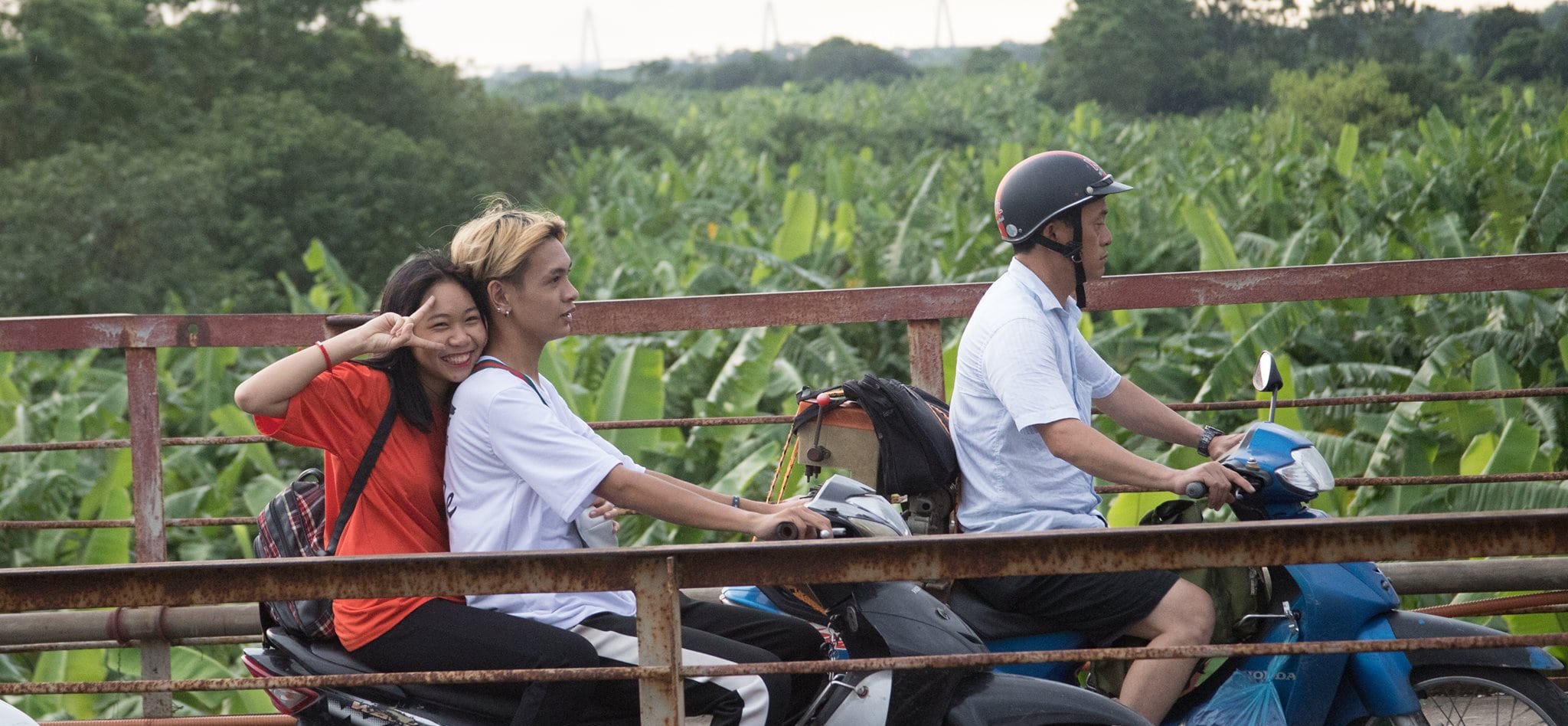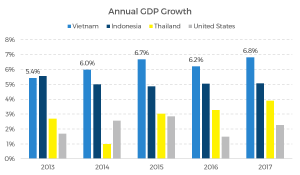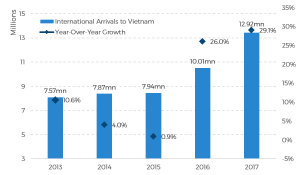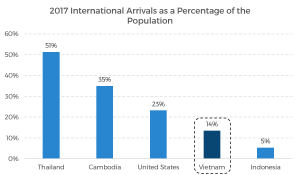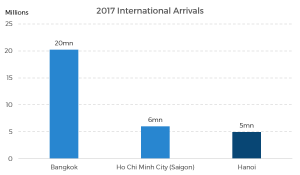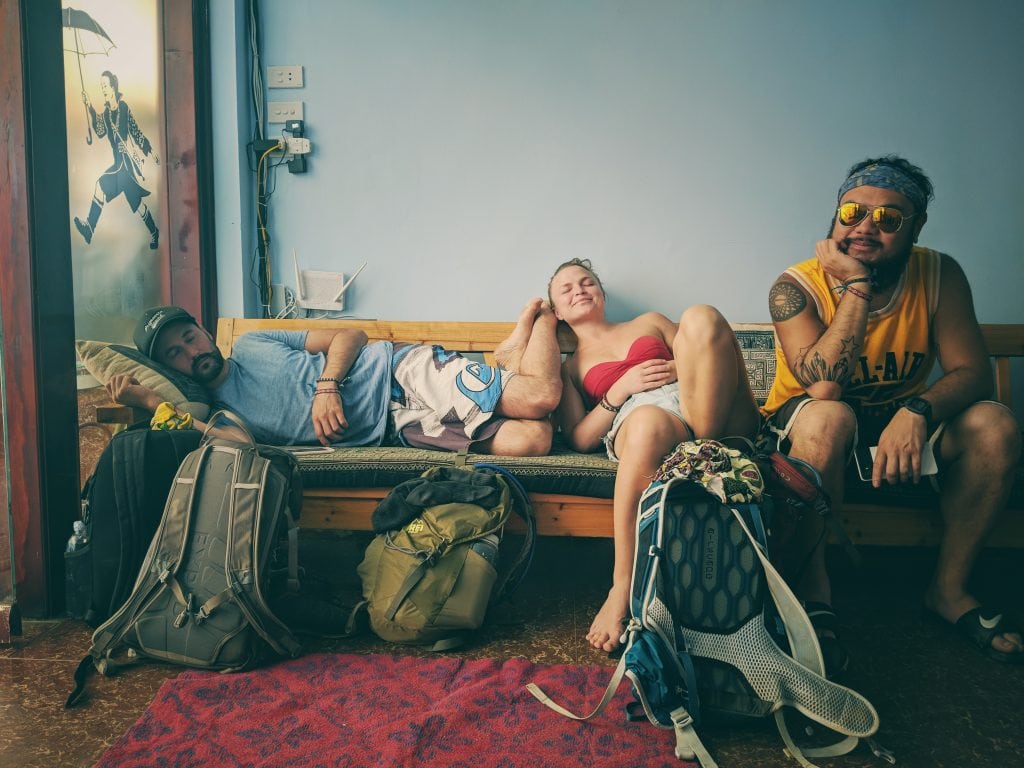Skift Take
Hanoi's economy is improving considerably, and tourism is growing, but for Vietnam's capital city to best position itself to develop as a responsible tourism destination, a change in mindset must occur. And that change needs to come from the young Vietnamese of today.
Skift Senior Research Analyst Rebecca Stone is traveling the globe over the next year as part of Remote Year, a program that brings together working professionals to travel, live, and work remotely. She'll spend a month in 12 cities around the world that include Cape Town, Lisbon, Valencia, Sofia, Hanoi, Chiang Mai, Kyoto, Kuala Lumpur, Lima, Medellin, Bogotà, and Mexico City. And every month she'll take you along for part of the journey with a feature about her observations based on firsthand reporting and data about the changing travel industry. She'll do the jet lag. All you have to do is kick back and enjoy her compelling dispatches.
I fell in love with Hanoi’s cafe culture right away, and it wasn’t just because I’m a New Yorker addicted to coffee.
Hanoi’s cozy and unique cafes were typically filled with teenagers and millennials hanging out at all hours of the day. One of my favorite things to do in the capital city of Vietnam was to sip an iced coconut coffee (the French may have brought coffee to Vietnam, but the Vietnamese perfected the drink in the form of iced coconut coffees, egg coffees, and Vietnamese coffees) in an adorable cafe, Xofa, and people watch over the top of my laptop screen. I’d watch teenage couples cozy up to one another as if they were doing something rebellious no one else had ever done before. I’d observe millennials studying intently and wonder for what they were preparing. I’d see friends laughing over some story being told in Vietnamese that I couldn’t understand.
While I tried to imagine their life stories, what their upbringings were like, and what they hoped to do in the future, they all just looked eerily similar to me and my friends — sipping coffees while talking about our relationships, careers, families, and future goals.
Outside of the cafe, someone was probably cooking meat right on the sidewalk. Motorbikes were probably zooming by with babies on board without helmets. People were probably yelling at each other.
But, in that cafe, the room was buzzing with the possibilities of and hope for the future.
You see, Vietnam is still very much a developing country. While the economy is improving considerably and tourism is growing, Hanoi is still very much behind other comparable destinations in Southeast Asia.
Nevertheless, the idiosyncrasies and incongruities of Hanoi, with its traumatic history, culture unlike any other, and proximity to other incredible parts of Vietnam like Ha Long Bay, Ninh Binh, and Sa Pa, make it a perfect canvas for the development of a tourism industry that helps support and boost the overall economy.

Ha Long Bay is an incredible destination within driving distance of and easily accessible from Hanoi.
However, in order for the city to ready itself for the future and develop itself as a thriving tourism destination, a change in mindset must occur. And that change needs to come from those who didn’t see the war waged on their homeland, who were born in the age of the internet, who grew up in an experience-based economy, and who have big dreams of leading a life full of purpose.
Vietnam is still very much a developing country
Vietnam is unified as a communist country, but it has a history of being occupied by other nations. The French began militaristic activities in the area in the first half of the 19th century and established the Indochinese Union in 1887. Japan took over for a bit in 1940 after the French fell to Nazi Germany during World War II. China has occupied Vietnam during different time periods as well, and we’re all pretty familiar with the United States’ involvement in the country over a 19-year period ending in 1975. Vietnam has been occupied so frequently and seen so much war on its land, that I had to wonder what the country would be like today if other nations had simply left it alone.
Today, Vietnam’s gross domestic product (GDP) per capita is only around $2,300. For Indonesia and Thailand, which one might consider to be destinations comparable to Vietnam, their GDP per capitas are almost two times and three times, respectively, that amount. The United States’, though not really a fair comparison, is 25 times that amount.
Source: World Bank
Average monthly wages are around 5,066,000 VND (Vietnamese Dong), which translates to only about $216 per month. Internet users make up just over half the population (In the U.S., it’s three-quarters). The United Nations Development Programme’s Human Development Index, which offers a simplistic measurement of countries’ human development based on an unweighted average of a nation’s longevity, knowledge, and standard of living (life expectancy, education, and income), ranks Vietnam 115th (Thailand is 87th, and the U.S. is 10th).
Data suggests that corruption remains a major problem, and most power is held by the wealthy elite. Vietnam ranks 107th out of 180 in the Corruption Perceptions Index. Some 210 super rich Vietnamese people control 12 percent of the country’s wealth, and this group of ultra-high net worth individuals is the fastest growing upper-crust in the world.
I admit it was not difficult to notice these dichotomies simply by walking around Hanoi. Just outside my apartment building lived a family in a one-room home, and every day I walked by, I unsuccessfully attempted to count the number of family members living there. I would jump on the back of a Grab motorbike taxi and whiz through town, dodging people doing laundry, cooking meals, and raising children in street alleys and then pass by authoritative, governmental buildings guarded by bored-looking public security officers uniformed in a somewhat off-putting fern green.
Keep in mind, Hanoi is located in what was previously North Vietnam, the communist half of Vietnam established in 1954 after defeating the French. While, in some ways, it feels like a big village, it has the buzz of a growing city, combined with the vibes of an 1,000-year history, and an atmosphere of political importance and authority.
When it came to comparing Hanoi to Ho Chi Minh City (which even Hanoians still refer to as ‘Saigon,’ strangely enough), there was an unspoken sense that Hanoi is the wiser, more traditional, obedient older sister to the previous capital of South Vietnam, a modern, rebellious, metropolitan teenager. One Hanoian told me that the residents of Saigon are “wild,” implying they are not rule followers or potentially even good, authority-respecting people.
When I decided to go visit the Ho Chi Minh Mausoleum in Hanoi, I was told to get there at 7:30 in the morning to avoid having to wait in line for hours. I naively thought that meant there would be hordes of tourists showing up to catch a glimpse of the embalmed President Ho Chi Minh, but, to my surprise, it was actually hundreds of Vietnamese families silently lined up for half a mile to pay their respects to the revolutionary leader who gave them their freedom.
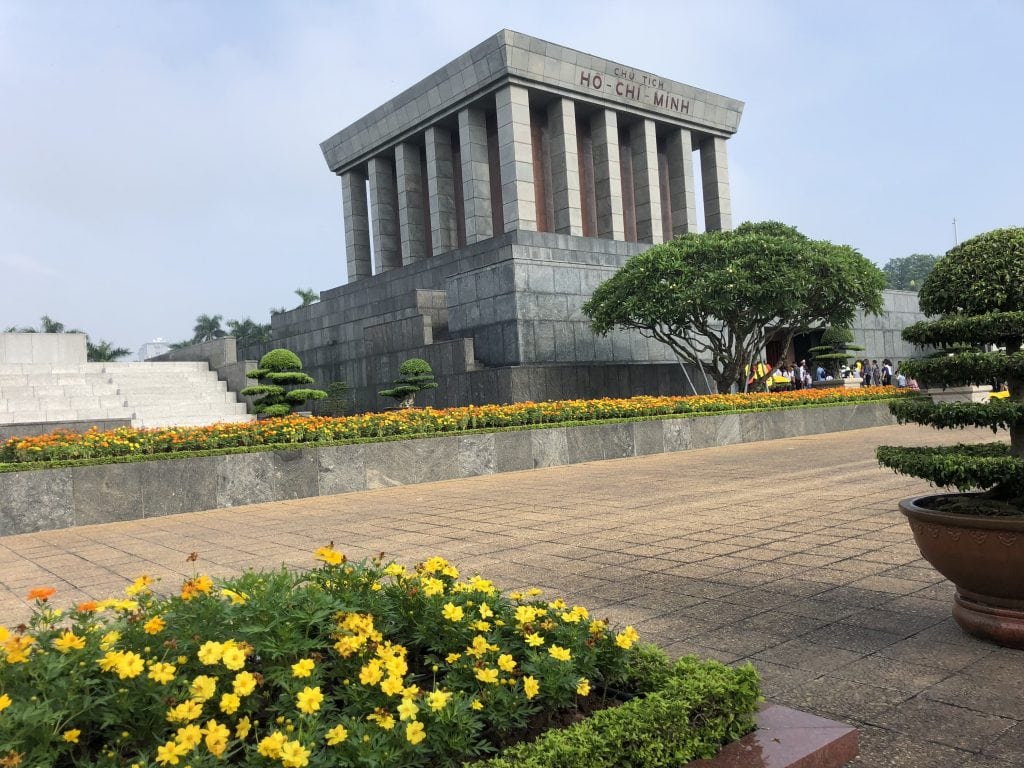
I snapped a quick picture of the Ho Chi Minh Mausoleum, although it was clearly inappropriate to have my phone out.
On the other hand, my parents, who came to visit me in Hanoi and then made their way south, told me a local in Saigon asked them point blank, “Why did you [America] abandon us in the war? Why did you leave us?” The country was clearly not as unified, politically or otherwise, as I had thought.
Escaping past occupation, Vietnam is finally growing on its own
For all its incongruities, Vietnam is very much developing, perhaps due to the combination of being somewhat left alone for a few decades and then increasingly opening up foreign relations with other nations. Annual growth in GDP has been outpacing peers, at 6.8 percent in 2017, and unemployment is currently around two percent. Vietnam was named one of the “Next Eleven,” countries expected to become important economies in the 21st century in 2005 by investment bank Goldman Sachs, and Jim O’Neill, an economist who was part of the project, still believes Vietnam stands out as one of the countries with the most potential.
Source: World Bank
Incomes are rising, standards of living are improving, education levels are increasing, and people are generally happier — Vietnamese consumer confidence is at historical highs. When I asked Vũ Tú Thanh Tâm, general manager of the Chi Boutique Hotel, located in the Hoan Kiem district of Hanoi, why the Vietnamese are so kind, hospitable, and smile so much (My inner New Yorker fights to pull out a responding smile sometimes), she explained, “From the inside, we are happier. That’s why we smile. It is our character: Simply hospitality.”
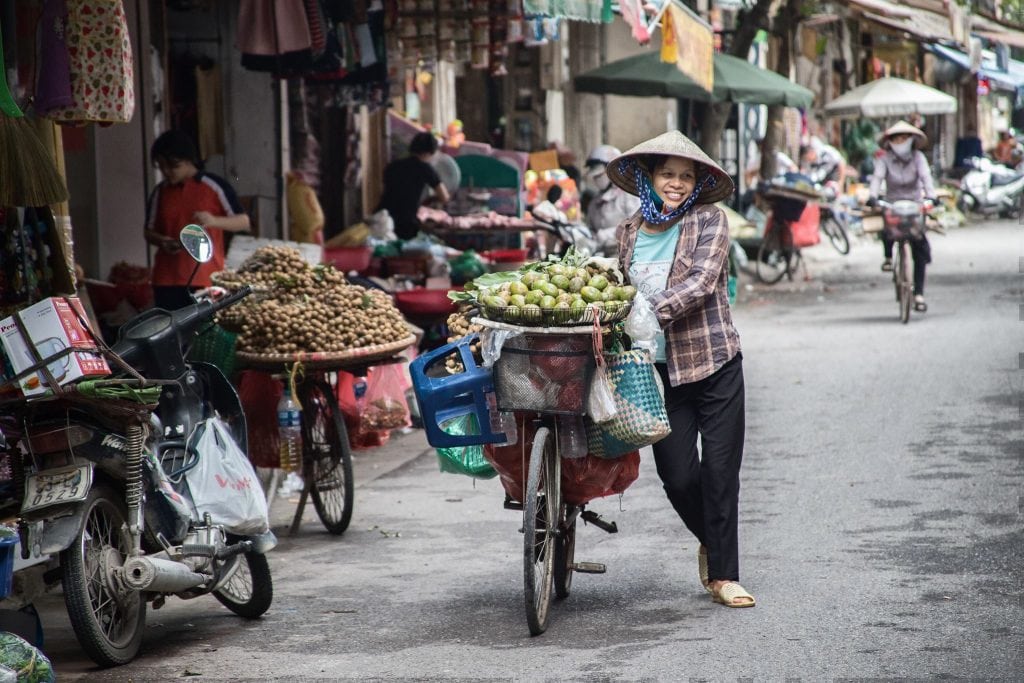
With income levels rising and standards of living improving, the Vietnamese are generally happier. Photographer: David April
Tourism is growing as well. Last year, Vietnam welcomed almost 13 million international arrivals, representing a 13.5 percent 5-year compounded annual growth rate. Hanoi specifically had almost 5 million international arrivals, up 23 percent year-over-year and coming in 15 percent above targets. The World Travel and Tourism Council forecasts travel and tourism will make up almost 10 percent of GDP and eight percent of employment by 2028 (directly and indirectly).
Source: General Statistics Office of Vietnam
However, there is still considerable room for tourism development, as current visa restrictions create somewhat of a tourism bottleneck. Vietnam allows only 24 countries to visit visa-free; Thailand allows 57. Many travelers have to pay high fees and jump through complicated application hoops to obtain visas in order to simply visit Vietnam for a few days.
As a result, visitor penetration is still low. International arrivals to Vietnam represent 14 percent of the population; it’s 51 percent and 35 percent in Thailand and Cambodia, respectively. While Hanoi welcomed five million visitors last year, Ho Chi Minh City (Saigon) welcomed six million, and Bangkok welcomed 20 million. Clearly, there is still a lot more room for growth.
Source: World Bank, Reuters, The Cambodia Hotel Association, Indonesia Investments
Source: Vietnam.net, Forbes
Note: Bangkok is an estimation.
However, while other destinations, like Lisbon, would rather see tourists gone than have them continue to negatively impact cultures and the livelihoods of locals, Hanoians are excited about tourists coming to town. More than once, my friends and I caught teenagers taking pictures of us on their phones, and, while I felt like a celebrity, I knew I was just foreign to them. When I asked Hanoians directly if they liked having tourists in their city, every answer was a resounding “yes.”
“We love tourists … We don’t have a chance to travel,” Nguyễn Thị Hương Liên, CEO and founder of I Love Vietnam motorbike tours, indicated. It’s true that Vietnam ranks 86th in the Henley Passport Index, a ranking of all passports in the world based on the number of countries their holders can travel to without a visa. “It helps the economy of Vietnam grow.”
“I just love tourists,” Tim Lee, founder and managing director of Indochina Voyages, a tour agency offering 24/7 personalized services for travelers, explained. “I love the people, the travelers who share a lot of knowledge and information with me.”
The youth are the future
“At least people now are enjoying better living conditions and access to many more modern things, … [but] on the other hand, we do face a lot of problems like unclean food, etc. … I just think, well it’s much better than before,” said Mr. Tim, as we sipped iced coconut coffees next to West Lake, an area where a lot of expats live. “But I believe in the people of the next 20 years. It’s enough for a new generation to be born, and many people are now sending their children abroad.” It is true that Vietnam came in 6th with the largest group of foreign students (over 22,000) studying in the United States last year.
“I hope that with the education and the lifestyle and the benefits of the western countries, they will bring those ideas home and work strongly to create a better country in the future.”
I remember rolling my eyes growing up when people said, “The youth are the future.” Isn’t that a given? The youth are going to be the future. And when they grow up, the next generation of youth will be the future. And when they grow up, the next generation of youth after them will be the future. You get the idea.
“The country is developing, and education is improving, and people have better, open minds,” Ms. Tâm of the Chi Boutique Hotel spoke optimistically. “For the young people, they have a different [mindset], and they [are] stronger than us. They’re … ready to change. I think it’s good.”
After being in Hanoi for some time, I, too, started to see a theme emerge: in order for Vietnam to move forward into the future and away from its past, the never ending cycle of expecting the youth to take care of the present’s problems in the future needs to be broken. A change in mindset needs to occur. And that change in mindset needs to come from the young Vietnamese of today.
Two-thirds of Vietnam’s population was born after the end of the Vietnam War. They have the internet; a lot of them know how to speak English; many of them have moved to the cities from the countryside for opportunities to study and to work. They are starting to have the ability and resources to have big dreams about what they can achieve and what their country can be.
However, not all young adult Vietnamese are currently focused on making a difference.
Ngô Ngọc Lân, executive assistant manager of Au Coeur d’Hanoi Boutique Hotel noted, “Right now, the young people don’t have … [a view] about the increase in the economy in Hanoi or the country … They spend their time worrying about jobs and [family].”
An anonymous local even told me, “I think the young people are excited about their future. I don’t think they’re excited about the future of their country.”
Because Vietnam is still very much in a developmental phase, but also because about 30 percent of the population consists of millennials who are about to enter prime career years, there is an incredible opportunity to impact the trajectory of Hanoi and the country.
A case study in the youth stepping up to take ahold of the future
Nguyễn Thị Hương Liên of I Love Vietnam motorbike tours, who I sat down with over Vietnamese coffees in Xofa, is a perfect example of what the youth taking ahold of the future looks like. Ms. Liên, currently aged 23, started her company when she was in college in Hue, a city in central Vietnam. Her company is now running scooter tours led by 100 female motorbikers (“lady bikers,” as she calls them) in Hue, Hoi An, Danang, Hanoi, and Saigon (Ho Chi Minh City) and has plans to expand into Laos. One lady biker leads the tour while the other motorbike drivers have the opportunity to learn, train, develop, practice English, and talk with the travelers on the tour about their experiences.
“I employ female university students [and women] who want to practice English [and] who want to give back to the community.” Ms. Liên explained. “Women have the potential to be leaders, but they need an environment to boost them up and support them because, … that’s how they can learn. They think they can do it, but they’re afraid. They’re afraid to take risks.” She went on to say, “We always say ‘together we go further.’”
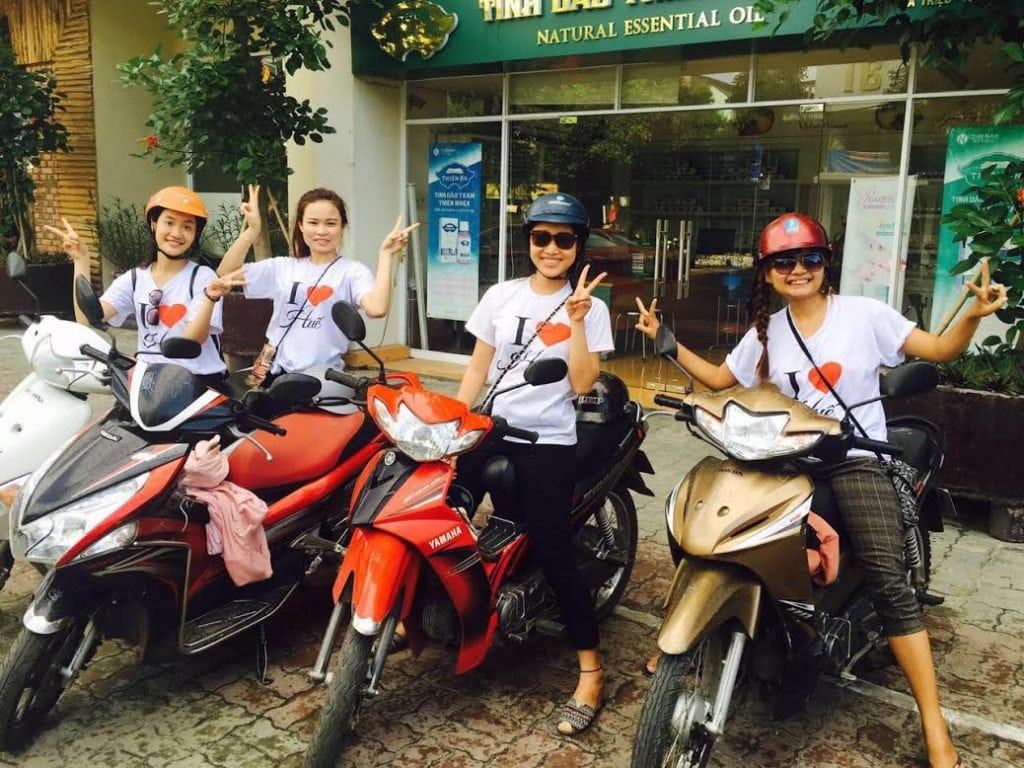
I Love Vietnam motorbike tours offer an opportunity for young women to develop their skills and become leaders in the tourism industry. Photo courtesy of I Love Vietnam tours.
I later asked Ms. Liên what young people can do for the tourism industry. “I would love to see more young people leading in the tourism industry,” she said. “I would love to see innovative ideas and the energy of the country led by the young generation, because people say you are never too young to lead, and I believe the young generation can make a change.”

Lady bikers show travelers motorbike culture during a tour, while also getting to hear about their experiences. Photo courtesy of I Love Vietnam tours.
What can young people can do to impact tourism in Hanoi?
So, what can young Vietnamese people do to make a change in the tourism industry?
- Take advantage of the internet and accessibility, of school and education, and of tourists traveling to Hanoi to learn what it is like around the world.
- Help implement policies that will provide for and support tourism.
- But never forget who you are, or what makes Hanoi, Hanoi.
Take advantage of the internet and accessibility, of school and education, and of tourists traveling to Hanoi to learn what it is like around the world. Study what other destinations and people are doing, how they’re developing, and form your own opinions about those practices.
Ms. Liên of I Love Vietnam Tours talked to me about how America is “so diverse, [with] diverse culture and diverse people. You can learn so much from different people. Different people bring different cultures for us to learn and to develop.”
Mr. Lân of Au Coeur d’Hanoi Boutique Hotel, who, by the way, is three years out of school and already the general manager of the hotel, highlighted, “One of the reasons I work in hospitality is because I want to meet people from other countries and learn from them about their culture.”
Meeting and learning about different people and places teaches you that ideas that are different from your own are okay, and sometimes even better; that normal is relative; that people all over the world have vibrant stories to tell. I had the privilege and opportunity to better understand Vietnamese culture, customs, and ideas.
I learned that if you just walk steadily and confidently across the street, the motorbike drivers will move swiftly around you, and, as a result, traffic feels almost smoother than if there were stoplights and rules. I learned adding egg yolks to coffee makes for an excellent milk replacement (though I never quite got used to the sweetness of condensed milk). I learned that aspects of the Vietnamese government and political policy are better than those of the U.S.

The motorbike traffic of Hanoi, though overwhelming at first, follows a steady rhythm that makes sense once you get into the groove of the city. Photographer: Cassie Loewen

Coffee may have been brought to Hanoi by the French, but the creation of egg coffee, traditionally prepared with egg yolks, condensed milk, and coffee is now a staple of Vietnamese cafe culture. These egg coffees pictured are from Cafe Đinh.
While I realize my ability to travel and expand my horizons is a luxury that many Vietnamese will never have, the youth can begin to immerse themselves in the world of today and form their own opinions.
Help implement policies that will provide for and support tourism.
Ms. Liên discussed how she has a built such a solid relationship with the municipality of Hue such that they give her support and the opportunity to grow her business. “If you want the government to change, come and talk with them … Because if you don’t talk, how can you cause change?”
In addition, as younger generations enter peak earning years, they will soon be the ones behind policy-making decisions for the country. They will have the opportunity to limit scamming, bribery, and corrupt behavior in the tourism industry, should they choose to.
When it comes to services and other requirements for the travel industry, policies regarding corruption, hygiene, and training may need to be reevaluated and emphasized. Tim Lee of Indochina Voyages noted that there are some people in the Old Quarter area who will “do big advertising, take the money [from the customer], and go. … The first thing [needed] is the right policies, and the second thing is the right investment in media and marketing … [And] the third thing that I hope is that they will reinforce what the policy is.”
Ms. Tâm of Chi Boutique Hotel brought up the fact that “Street food is nice for Hanoi, and our food is very delicious, but they [tourists] are still afraid if [everything] is hygienic or not … [Tourists have to] be careful in trying things. I want our government to try to help restaurants and train them … to understand hygiene and proper cleaning.”
Mr. Tim indicated that one of the hardest things he deals with is making sure his travel consultants are appropriately trained to best serve different types of travelers. “We want to be sure that there’s no culture shock that happens [and] that everything is in place … [offering] a well-oriented experience.”
But never forget who you are, or what makes Hanoi, Hanoi.
Over the course of my time spent living in Hanoi, I came to understand that sometimes when you walk down an alley looking for a restaurant, you might end up eating in someone’s home. I ate and enjoyed the likes of bún chả, spring rolls, and phở, despite the fact that I don’t usually eat pork, because that is what is custom. I learned that a family of five is a reasonable number of people to put on one single motorbike. I enjoyed hot soup with locals sitting on tiny, blue stools on the side of the street despite the fact that it was 95 degrees fahrenheit outside. I fell in love with the city for who it is.
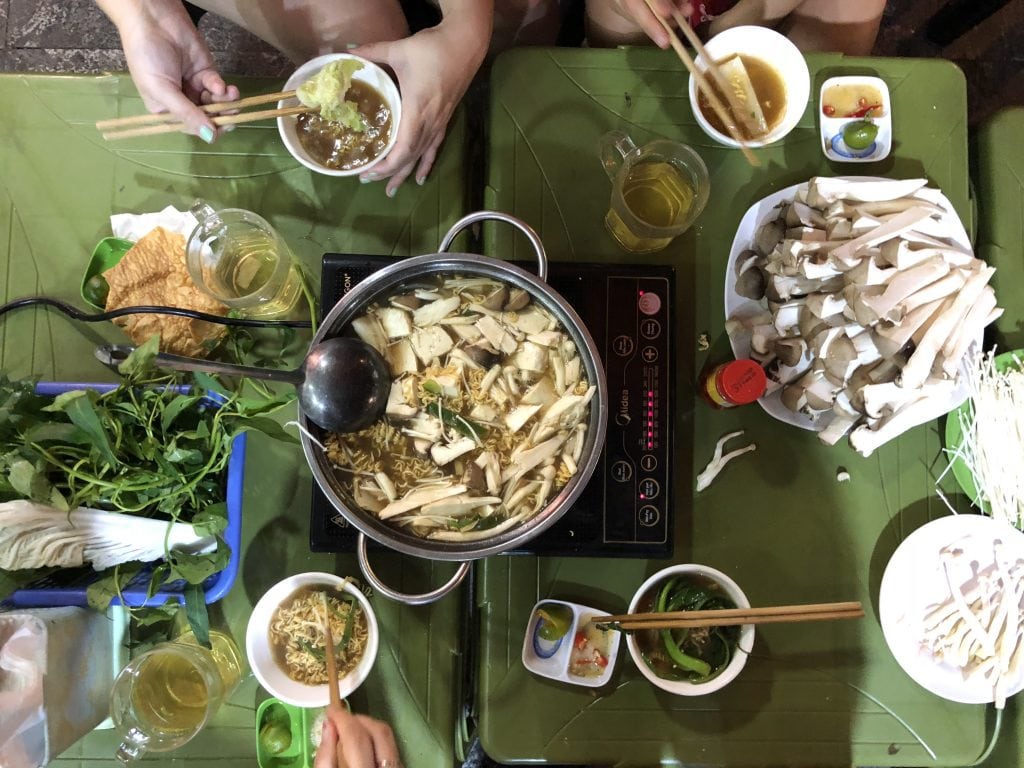
My friends and I enjoy a Vietnamese hot pot next to some locals. Not pictured is how sweaty we were.
Ms. Tâm of Chi Boutique Hotel noted that foreigners “come to Vietnam to find new lands, to discover pristine nature,” to see Vietnam in its raw, natural, untouched state.
“We have nice streets, small shops, and buildings with height restrictions,” Ms. Tâm indicated, all of which contribute to the culture and identity of Hanoi. “The government should have a policy to keep [and maintain] these things … If Hanoi changes into a big, [modern] city with a lot of high buildings, I think it won’t be as attractive to people.”
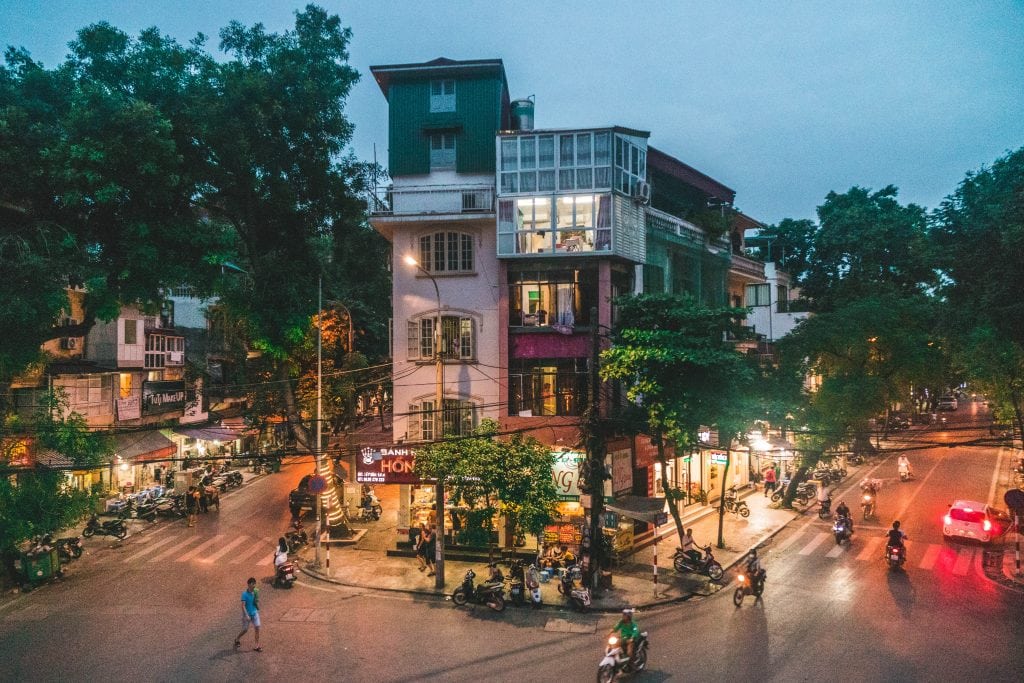
Young people should be dedicated to preserving Hanoi’s identity. Part of that includes maintaining Hanoi’s village-like feel, with height restrictions for buildings. Photographer: Cassie Loewen
While some younger people may want to employ certain Western ideas of modernity, they should never forget their Hanoian identity and customs. Focusing on maintaining Hanoi culture and authenticity will be what keeps it from being the next generic, touristy destination.
One day, a friend of mine was walking around exploring a lovely park, Công viên Thống Nhất, in the southern part of Hanoi. Several groups of Vietnamese high school students on a scavenger hunt approached her with a request in helping complete the task, “Take a picture of someone from a different country.”
In recounting the story to me, she laughed while saying, “It was so cool to see a group of kids from a completely different country acting the exact same way a group of kids from America would act. They were hanging out with friends, taking pictures, texting, laughing … just being kids.”
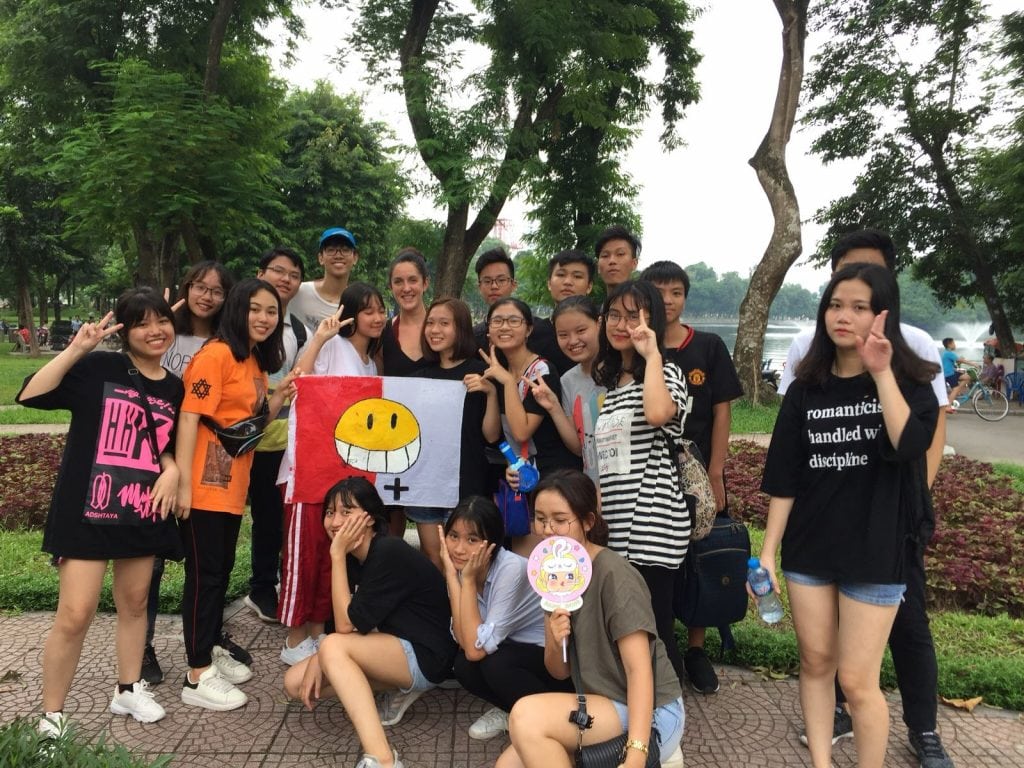
My friend helping Vietnamese students cross one item off the list in their scavenger hunt. Photo courtesy of Stephanie Jones.
Tourism is so powerful because it provides all of us, whether we’re the ones traveling or the ones taking pictures of travelers, an incredible opportunity to grow, to adapt, to learn. Tourism creates jobs, allows sharing of best practices, influences every other industry, provides business opportunities, and encourages international collaboration. It also brings us closer together and makes us realize we really aren’t that different from each other at all. We are all part of an increasingly integrated world, and what you choose to do or not do will have lasting ramifications on the world forever.
As a result, the youth should feel empowered to break the cycle and get involved with the development of tourism in their cities. They are the future after all.
The Daily Newsletter
Our daily coverage of the global travel industry. Written by editors and analysts from across Skift’s brands.
Have a confidential tip for Skift? Get in touch
Tags: climate change, data and discovery, skift on the road, sustainability, tourism, vietnam
